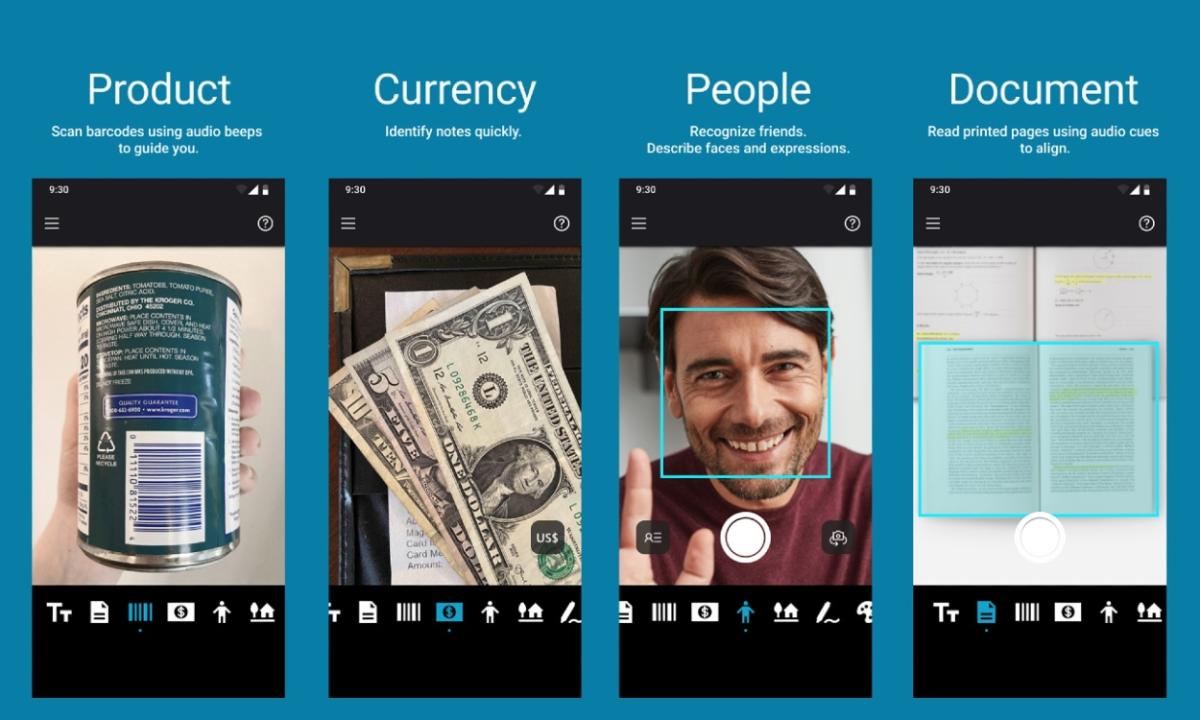
Image via Microsoft
Seeing AI is a free app by Microsoft available to mobile devices from Apple and Android that helps people who are blind or have low vision navigate the world. This app uses augmented reality, artificial intelligence (AI), and aural technology to accomplish a number of tasks its users can rely on.
An assistive technology for blind and low-vision people
To start off, Seeing AI provides ten different functions such as reading short texts and documents, using barcodes to identify products, describing scenes in a picture, recognizing faces and counting people, identifying and reading currency notes, reading hand-written texts, describing the world in real time around the user, and using sound to help the user tell the brightness of the environment. Because of the nature of the disability in the user’s sight, the app has to use other forms of the human senses to convey visual information. Therefore, image-to-speech as well as sound signaling are heavily used in the app.
This assistive technology draws on a couple of characteristics such as utility, usability, accessibility, desirability, and affordability. Seeing AI is an app that has been shown to be very helpful to the blind and low-vision community, especially for those who don’t always have a sighted companion with them to help navigate the world when needed. The interface has high contrast with enlarged icons, and when moving to the next feature, a voice reads out the name of the feature so that users can navigate the app without difficulty. In addition, the reader’s voice and speaking speed can be changed as well. As for desirability, the ownership of this app leads to satisfaction and interest from people who do not need vision-related assistive technology for its use in the newest technology in AR and AI. The look and feel of the interface do not stray too far from a non-assistive AR and AI app either. Last but not least, this app is affordable in the sense that it is free for anyone to download and use. The only part that would be more unaffordable would be the phone itself. But because it is now available on Android, it opens up its availability for more affordable phones in the market.
Seeing AI is a technology that exists in a world within the social model of disability. In our current society, much of our understanding of the world is through sight. Humans rely on sight the most compared to other senses like hearing, smell, taste, or touch when processing information. A lot of the infrastructure today does not make noises or use audio as a signal of their existence or convey meaningful information. Because of this lack of accessibility, Seeing AI becomes the solution to address this issue through the functional model of disability. For example, in daily living and navigation, the real time audio descriptions is especially important when the user is out and about. It can help them read street signs, store banners, and describe what the environment is currently like, since these things don’t have audio signals nor braille for these users. The product identity feature is also useful in making sure that the user is getting the correct item at grocery stores when many packaging look alike for people with low-vision. All of these features improve the user’s quality of life by making it possible to be self-sufficient when there is a lack of assistance in the current society for the blind and low-vision community.
On the other hand, this app also enables the medical model of disability. The medical model of disability proposes that blindness, low-vision, and colorblindness are deficiencies that should be treated or managed. For example, a person who is born blind or colorblind may not need to identify colors if it doesn’t benefit them. However, Seeing AI has the capability to describe the color of an object that is being pointed at. Sometimes people who are colorblind get frustrated when having to discern colors especially when they are unable to see the difference themselves to believe it otherwise. It is important to consider what sighted people see as ‘normal’ as also normal to the blind, low-vision, and colorblind communities. Overall, Seeing AI is still a successful assistive technology to help blind and low-vision people in their everyday interactions with the world.
References
- Coleman, G. B. (2019, February 27). Making sense of how the blind “see” color. Harvard Gazette. https://news.harvard.edu/gazette/story/2019/02/making-sense-of-how-the-blind-see-color/
- Saqib Shaikh, F. and L. (2023, December 14). Seeing AI app launches on Android – including new and updated features and new languages. Microsoft Accessibility Blog. https://blogs.microsoft.com/accessibility/seeing-ai-app-launches-on-android-including-new-and-updated-features-and-new-languages/
- Seeing AI: App for the blind & partially sighted: Guide dogs. App for the Blind & Partially Sighted | Guide Dogs. (n.d.). https://www.guidedogs.org.uk/getting-support/information-and-advice/how-can-technology-help-me/apps/seeing-ai/
- Sprouse, S. (2022, July 20). Making sense of your five senses. Ask The Scientists. https://askthescientists.com/senses/#:~:text=Vision%20is%20often%20thought%20of,eyes%20when%20you%20look%20around
- Veronica. (2022, October 28). Microsoft seeing AI and low vision review. Perkins School for the Blind. https://www.perkins.org/resource/microsoft-seeing-ai-and-low-vision-review/